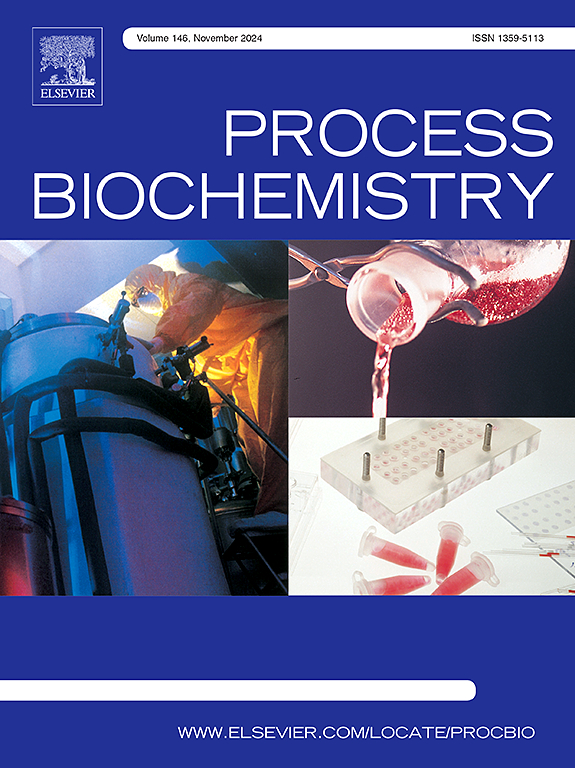低温生物炭通过调节酶化学计量和微生物群落演替来改善堆肥过程
IF 4
3区 生物学
Q2 BIOCHEMISTRY & MOLECULAR BIOLOGY
引用次数: 0
摘要
研究了低温和高温生物炭对牛粪和玉米秸秆共堆肥过程中碳(C)、氮(N)、磷(P)转化和微生物演替的影响。酶化学计量学检测有效地估计在堆肥过程中的变化。低温生物炭的加入提高了堆肥温度。堆肥产物腐植酸含量比高温生物炭和对照分别提高了10.77 %和64.49 %。此外,堆肥中萌发指数(GI)和总固形物(TS)含量也分别提高了11.21 %、6.06 %和25.50 %、5.01 %。低温生物炭处理显著提高了β- d -葡萄糖苷酶(BG)、β- n -乙酰氨基葡萄糖苷酶(NAG)、亮氨酸氨基肽酶(LAP)和碱性磷酸酶(AKP)活性。另一方面,lnBG/ lnAKP和ln (LAP + NAG)/lnAKP分别代表的潜在碳磷比和氮磷比显著降低。低温生物炭由于其独特的理化性质,改变了在堆肥过程中起特定作用的变形菌门、厚壁菌门和Luteimonas、窄养单胞菌等细菌类群的丰度。冗余分析表明,在堆肥过程中添加低温生物炭调节了微生物群落演代,提高了酶活性,解除了微生物养分转化过程中C、N、P有效性的限制,从而提高了堆肥质量。本文章由计算机程序翻译,如有差异,请以英文原文为准。
Low-temperature biochar for improving composting process via regulation of enzymatic stoichiometry and microbial community succession
This study investigated the effects of low-temperature and high-temperature biochar on carbon (C), nitrogen (N), and phosphorus (P) conversion and microbial succession during the co-composting of cow manure and corn stover. Enzymatic stoichiometry was examined to effectively estimate the changes in the process of composting. The addition of low-temperature biochar raised the composting temperature. Moreover, the humic acid content in the compost product increased by 10.77 % and 64.49 %, compared to the high-temperature biochar and the control, respectively. In addition, the germination index (GI) and total solids (TS) content in compost also increased by 11.21 %, 6.06 %, and 25.50 %, 5.01 %. Low-temperature biochar application significantly increased the activities of β-D-glucosidase (BG), β-N-acetylglucosaminidase (NAG), leucine aminopeptidase (LAP), and alkaline phosphatase (AKP) activities. On the other hand, the potential C/P and N/P acquisition activities represented by lnBG/ lnAKP and ln (LAP + NAG)/lnAKP, respectively, decreased significantly. Owing to the unique physicochemical properties, low-temperature biochar altered the abundance of bacterial taxa, such as Proteobacteria, Firmicutes and Luteimonas, Stenotrophomonas, which play specific roles in the composting process. Redundancy analyses showed that low-temperature biochar added during the composting process regulated the microbial community succession, improved enzyme activity, and lifted the limitation of C, N, and P availability during microbial nutrient conversion, thereby improving the compost quality.
求助全文
通过发布文献求助,成功后即可免费获取论文全文。
去求助
来源期刊

Process Biochemistry
生物-工程:化工
CiteScore
8.30
自引率
4.50%
发文量
374
审稿时长
53 days
期刊介绍:
Process Biochemistry is an application-orientated research journal devoted to reporting advances with originality and novelty, in the science and technology of the processes involving bioactive molecules and living organisms. These processes concern the production of useful metabolites or materials, or the removal of toxic compounds using tools and methods of current biology and engineering. Its main areas of interest include novel bioprocesses and enabling technologies (such as nanobiotechnology, tissue engineering, directed evolution, metabolic engineering, systems biology, and synthetic biology) applicable in food (nutraceutical), healthcare (medical, pharmaceutical, cosmetic), energy (biofuels), environmental, and biorefinery industries and their underlying biological and engineering principles.
 求助内容:
求助内容: 应助结果提醒方式:
应助结果提醒方式:


